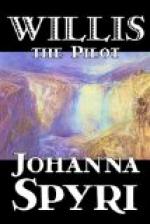“You will permit me to believe, my son, at least till the contrary has been proved, that these actions to which you refer have nothing at all to do with coquetry. Those brilliant colors are designed for a purpose other than that which you suppose; they serve as signals to keep the community together, or, in other words, they are a common centre round which the hens may revolve.”
“The transition from apes to heathcocks,” remarked Jack, “appears to me somewhat abrupt.”
“Not so abrupt as you think, Master Jack,” said Wolston; “those who take the trouble to study Nature, observe an admirable gradation and easy progression from a simple to a complex organization. There is no race or species that is not connected by a perceptible link with that which precedes and that which follows.”
“What relation is there, for example,” inquired Jack, “between an oyster and a horse?”
“No immediate relation certainly, but there are intermediate links by which the two are brought together: they may be regarded, however, as the opposite extremes of the brotherhood—the two poles in the chain of existence. A horse bears even less resemblance to a turnip than to an oyster; a relationship may, nevertheless, be traced, step by step, between them, dissimilar as they are. There is the polypus, that singular product of Nature, which, regarded in one light, performs all the functions of animal life, whilst, when regarded in another, it has the ordinary attributes of a plant; does this not clearly and distinctly mark the transition from the vegetable to the animal kingdom? Again, certain species of worms blend the animal with the insect tribe, those which are covered with a horny substance unite them with the crustaceae. These approach fish on the one hand, and reptiles on the other, whilst reptiles in some species become moluscs.”
“And what is a molusc?” inquired Willis.
“The term molusc is applied by naturalists to creatures which have no vertebrae, as for example, the cuttle fish and the oyster.”
“I believe you, Mr. Wolston; but if I had asked Ernest or Jack, they would have told me that it was a commodore or an admiral.”
“Reptiles, I was going to say, are connected at one end of the chain with moluscs by the slug, and at the other with fish by the eel. From flying-fish to birds the transition is by no means abrupt. The ostrich, whose legs are like goat’s, and runs rather than flies, connects birds with quadrupeds; these again return to fish through the cetacea.”
“Yes, but the interval between such creatures and man is still great.”
“True; to connect the two would be a process replete with insurmountable difficulties, and only possible to creative power. The projecting snout would have to be flattened, and the features of humanity imprinted upon it—that head bent upon the ground would have to be directed upwards—that narrow breast would have to be flattened out—those legs would have to be converted into flexible arms, and those horny hoofs into nimble fingers.”




